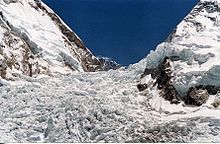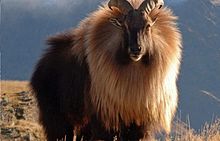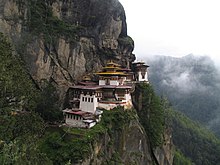Himalayas
The mountains consist of large glaciers, which are remnants of the last ice age, and give rise to some of the world's major rivers such as the Indus, Ganges, and Tsangpo–Brahmaputra.[7][8] The name of the range is mentioned as Himavat (Sanskrit: हिमवत्) in older literature such as the Indian epic Mahabharata, which is the personification of the Hindu deity Himavan.The Himalayas run as an arc for 2,400 km (1,500 mi) from west-northwest to east-southeast at the northern end of the Indian subcontinent, separating the Indo-Gangetic Plains from the Tibetan Plateau.[20][21] The Sivalik Hills form the lowest sub-Himalayan range and extends for about 1,600 km (990 mi) from the Teesta River in the Indian state of Sikkim to northern Pakistan.The name derives from Sanskrit meaning "Belonging to Shiva", which was originally used to denote the 320 km (200 mi) stretch from Haridwar to the Beas River.The high altitude regions are uninhabitable with few mountain passes inbetween that serve as crossovers with the human settlements in the lower valleys.[32] The Assam Himalaya forms the eastern most sub-section that extends eastward for 720 km (450 mi) from the Indian state of Sikkim through Bhutan and north-east India past the Dihang River to the India-Tibet border.During miocene (20 mya), the increasing collision between the plates resulted in the top layer of metamorphic rocks getting peeled, which moved southwards to form nappes with trenches in between.[34][38] The summit of Mount Everest is made of unmetamorphosed marine ordovician limestone with fossil trilobites, crinoids, and ostracods from the Tethys ocean.[34] The Himalayas and the Central Asian mountain ranges consist of the third-largest deposit of ice and snow in the world, after the Antarctic and Arctic regions.[54] Since the late 20th century, scientists have reported a notable increase in the rate of glacier retreat across the region as a result of climate change.While the mountains were formed gradually, the rivers concurrently cut across deeper gorges ranging from 1,500–5,000 m (4,900–16,400 ft) in depth and 10–50 km (6.2–31.1 mi) in width.[67][74] Due to its location and size, the Himalayas acts as a climatic barrier which affects the weather conditions of the Indian subcontinent and the regions north of the range.The post monsoon season is largely devoid of rain and snow before beginning of cold winters in December-January with intermediate spring before the summer.[79] The effect of Himalayas on the hydroclimate impacts millions in the plains as the variability in monsoon rainfall is the main factor behind wet and dry years.[94] The increased warming and melting of snow is projected to accelerate the regional river flows until 2060 after which it would decline due to reduction in ice caps and glacier mass.The extreme weather events might cause physical harm directly and indirectly due to lack of access and contamination of drinking water, pollution, exposure to chemicals, and destruction of crops, and drought.Tropical and subtropical broadleaf forests are mostly constricted to the high temperature and humid regions in Eastern and Central Himalayas, and pockets of Kashmir in the west.Major vegetation include Juniperus, Rhododendron on rocky terrain facing the Sun, various flowering plants at high elevations, and mosses, and lichens in humid, shaded areas.[74] The Himalayas are home to various medicinal plants such as Abies pindrow used to treat bronchitis, Andrachne cordifolia used for snake bites, and Callicarpa arborea used for skin diseases.The population of the Himalayas has grown considerably over the last five decades from 19.9 million in 1961 with the annual growth rate (3.31%) more than three times higher than the world average (1.1%) during the same period.The major human migration towards the Himalayan region occurred in 2000 BCE when Aryans came from Central Asia and progressively settled along the plains to the south.Various ethnic people such as Ladakhi, Balti, and Dard live on the north of the Great Himalayas along the Indus basin in the Kashmir and Ladakh regions spread across India, Pakistan, and China.People of various ethnicity such as Newar, Tamang, Gurung, Magar, Sherpa, Bhutia, Lepcha, and Kirat, who speak Tibeto-Burman languages, are spread across the mountainous regions of Nepal, Bhutan, and parts of North East India.The Indian state of Arunachal Pradesh along the eastern edge is home to various Tibeto-Burman speaking ethnic groups such as Abor, Aka, Apatani, Dafla, Khamti, Khowa, Mishmi, Momba, Miri, and Singpho, who mostly practice shifting cultivation.The Himalayan region is occupied by people of various religions and several places in the Himalayas are of religious significance in, Bon, Buddhism, Hinduism, Islam, Jainism, and Sikhism.[139][140] In Jainism, Mount Ashtapada of the Himalayan mountain range is a sacred place where Rishabhanatha, the first Jain tirthankara, attained liberation.[144][115] Due to the higher rate of flow of the Himalayan rivers, they have been dammed at multiple places for development of irrigation facilities and generation of hydroelectricity.In the Western Himalays, coal is found in Jammu region, bauxite, copper, and iron ore in Kashmir valley, borax and sulfur in Ladakh, and semi precious stones such as sapphire in Zanskar range.[144] There are a number of hill stations and religious centers on the lower ranges of the Himalayas and hence tourism is an important economic activity in the region.

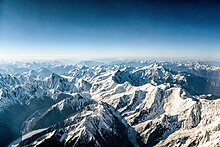
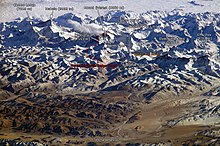
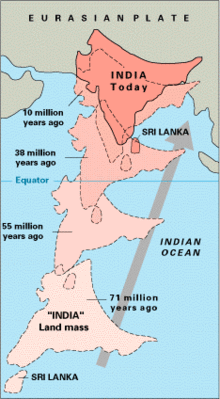














Himalaya (disambiguation)eight-thousandersIndo-Gangetic PlainTibetan plateauGangesYarlung TsangpoBrahmaputraMount EverestElevationCoordinatesHindu KushCountriesAfghanistanBhutanPakistanContinentOrogenyAlpine orogenyRock ageCretaceousCenozoicRock typesMetamorphicsedimentarymountain rangeplainsIndian subcontinentseveral peakshighest mountainsix countriesKashmirKarakoramNanga ParbatIndus riverNamcha BarwaYarlung Tsangpo RiverSivalik HillsLower HimalayasGreat HimalayasTibetan HimalayasformedsubductionIndian tectonic plateEurasian Plateconvergent boundaryseismicallyglaciersice ageworld's major riversTsangpodrainage basinendorheicCentral Asiamonsoonssubtropicalcold and dry desertSouth AsiaIndianTibetanHinduismBuddhismJainismGangkhar PuensumMachapuchareKailashSanskritHimavatIndian epicMahabharataHimavanNepaliBengalisimplified Chinesetraditional ChinesepinyinChineseEmily DickinsonHenry David ThoreauList of Himalayan peaks and passesHimalayan RimIndo-Gangetic PlainsPakistan-administered KashmirTibet Autonomous RegionTeesta RiverSikkimHaridwarBeas RiverChuria RangeLower or Lesser HimalayaGreater HimalayasArunachal PradeshgraniteWestern HimalayaswesterncentraleasternSatlejHimachal PradeshZanskarPir Panjal RangesKumaonUttarakhandnorthern IndiaKali Rivertemperate climateNanda DeviEastern HimalayasNorth East IndianWest BengalTeesta RiversKanchenjungaMakaluAssam HimalayaDihang RiverNathu LaJelep LaGeology of the HimalayasIndia landmassmetamorphic rockplate tectonicscontinental collisionEurasian PlatesJurassic periodTethys OceanGondwanaIndo-Australian plate
